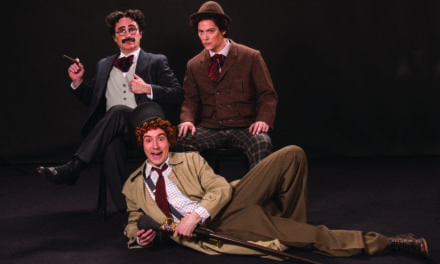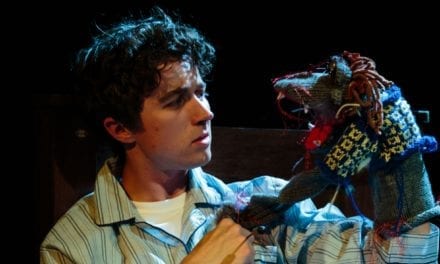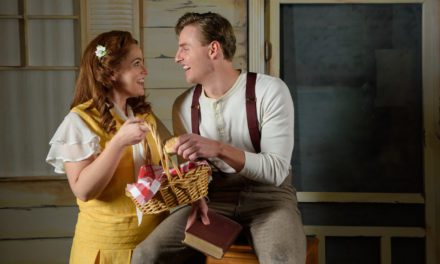PROVO — One of the reasons I keep going back to the theatre because of my hope that a director and cast can present a script that I’m familiar with in such a novel way that I gain new insights into the story or the characters. It doesn’t happen very often, but when it does, I find it wonderfully satisfying. Although there is comfort in Belle always wearing a yellow dress when she dances with the Beast, or in a humongous French flag being waved upstage during a rousing patriotic anthem, I find that being surprised and enlightened is always more memorable than watching a production that presents a play the way it’s “supposed to” be presented.

Show closes November 17, 2012.
BYU’s production of Little Shop of Horrors gave me new insight on the script because it breaks all the rules. There is no giant plant on stage, no grungy Skid Row set, and no bizarre assortment of dental tools. Because of this, I’ll remember the production for many years to come. I’m not sure all of the innovations in staging and the technical changes (all without changing a word in the script or altering the score) worked, but this was one of the rare productions that reminds me why I keep attending productions of plays I’ve seen before.
Director Carson Wright helmed this unique production, and he chose to replace the traditional Audrey II puppets with a human actor (Ted Bushman) playing the malevolent plant. I was extremely skeptical about this change at first, but I grew to accept it before the first act was finished. Bushman was able to give greater depth and subtlety to Audrey II than I had seen in any other productions of Little Shop of Horrors (including the film version). With a human being standing in for the giant plant, I realized more forcefully than ever how much Audrey II knew about the human characters in the show and why he was able to manipulate Seymour so well. By the second act Bushman was a creepy presence in all the flower shop scenes and even subtle actions like opening his eyes or changing his position in his chair had dark overtones. The final result was the most developed and three-dimensional Audrey II that I had ever seen.
Wright also chose to play the story more straight than usual, choosing instead to focus on the emotional core of the story: Seymour and Audrey’s developing relationship. In an early scene working in the flower shop, the two characters seemed vulnerable and careful as they explored their feelings without explicitly telling each other about their love for one another. In later scenes Wright carefully explored these feelings until they culminated in the rapturous “Suddenly Seymour,” which I found greatly satisfying (thanks also to the work of music director Brooklyn Poulter).
 Whitley Osborn played Audrey, the love interest of the main character, who is already taken by her abusive boyfriend, Orin Scrivello (Peter Layland). Osborn revealed the sweet and tender nature of her character during “Somewhere That’s Green;” Osborn’s wistfulness as she sang the song and her body language showed that Audrey was a person with a beautiful soul among ugly surroundings. Osborn provided a great contrast, though, during “Suddenly Seymour,” in which she belted the chorus and showed great passion. Her counterpart, Brandon Roach in the role of Seymour, wasn’t as profound in his performance, but still was satisfying in meeting the demands of the role. Roach sang well and created a Seymour that was loveable in his social awkwardness. Overall, I’d say that Roach’s performance was one of the more conventional aspects of this production.
Whitley Osborn played Audrey, the love interest of the main character, who is already taken by her abusive boyfriend, Orin Scrivello (Peter Layland). Osborn revealed the sweet and tender nature of her character during “Somewhere That’s Green;” Osborn’s wistfulness as she sang the song and her body language showed that Audrey was a person with a beautiful soul among ugly surroundings. Osborn provided a great contrast, though, during “Suddenly Seymour,” in which she belted the chorus and showed great passion. Her counterpart, Brandon Roach in the role of Seymour, wasn’t as profound in his performance, but still was satisfying in meeting the demands of the role. Roach sang well and created a Seymour that was loveable in his social awkwardness. Overall, I’d say that Roach’s performance was one of the more conventional aspects of this production.
One of my favorite aspects of Little Shop of Horrors is its chorus of street urchins, Ronnette, Chiffon, and Crystal (played by Oyoyo Bonner, Lauren Hughes, and Alicia Shumway). These characters function as a Greek chorus, participating in and commenting on the action. The three performers in these roles gave their characters unique personalities that brought them beyond the role of “backup singers.” I appreciated, for example, how Bonner’s character was the ringleader of the three and how Shumway’s character was hardened and callous towards her surroundings. I also found the three performers’ choreography (created by Wright and the cast) a joy to watch, especially in “Meek Shall Inherit,” “Skid Row,” and “Ya Never Know.” All three performers were also excellent in enunciating their lyrics, and I understood some words in “Suppertime,” “Closed for Renovations,” and “Skid Row” for the first time ever.
The only acting performance that didn’t please me completely was from Jacob Ludlow as Mr. Mushnik. I wish that Ludlow’s character had more disdain for Seymour. As I saw it, Mushnik seemed annoyed by Seymour, but didn’t loathe the young man. Consequently, the song “Mushnik and Son” seemed to ring hollow because Mushnik’s change of heart wasn’t very great. But I enjoyed Layland’s performance as Orin Scrivello and all the minor characters in the play, especially in “The Meek Shall Inherit,” in which he took on three minor roles in quick succession.
Visually, this production—much like the production of Merrily We Roll Along in the same facility last March—has aspects that are more similar to a concert than a full production. There is no scenery and every performer wears only a single costume. Moreover, in this Little Shop of Horrors, all the props are made of painted cardboard. Some audience members will simply have difficulty accepting this simple visual style; others will appreciate the chance to use their imagination. These artistic choices are what they are. But they do match up with the decision to have Audrey II played by a person and not a puppet. Whether these decisions work or not will depend largely on the opinions of individual audience members and their willingness to accept a bare-bones production of Little Shop.
Not all of Wright’s artistic choices worked for me, but I can’t escape the fact that this production of Little Shop of Horrors was innovative and insightful. Fans of the show should see the production in order to see a new twist on an old favorite, and newcomers to the play can enjoy a production that is as surprising as any traditional staging. When I first entered the theater, I wasn’t sure that there could be a worthwhile production of Little Shop of Horrors without puppets. But I was wrong. “Don’t it go to show ya never know?”




